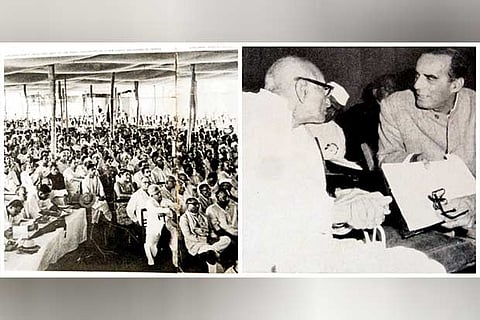

Chennai
In a 1959 public meeting in Mylapore Vivekananda College, organised by the All India Agriculturists’ Federation, an 81-year-old politician, ignoring his aches, ailments and age announced the formation of a new political outfit. Swatantra Party was not a trivial organisation, but a pan-India party to challenge the Nehruvian might. With his days running out, the elderly man was certainly fighting his greatest foe after the British left.
And in the political spectrum except for this old man who hobbled around with a walking stick, there were few who could match the magnetism of Jawaharlal Nehru. The octogenarian had been India’s only native Governor General. He was also Gandhi’s best friend, who the Mahatma often equated to his own conscience. He was C. Rajagopalachari informally called Rajaji.
Opponents of Congress had for years begged Rajaji to take on Nehru. Rajaji tarried saying he was too old, too long a Congressman and too intimate to Nehru.’ But Nehru’s Nagpur agricultural policy that advocated government control of grain trade, ceilings on land holdings and co-operative agriculture made him change his mind.
Rajaji felt the welfare of the citizenry could be achieved only with minimal state intervention. Rajaji was at that time likened to an aging Quixote poking his lance at the windmills of ‘statism’.
The idea of the right liberal party actually originated with a pale-skinned Bombay Parsi speaking in a stylish English drawl — Minocher Rustom Masani. He studied in London School of Economics and trained as a lawyer in Lincoln’s Inn. Masani wanted “a home-spun and unpretentious leader with entrenched roots in Indian tradition and was honest enough to accept that it wasn’t him.”
Rajaji convened a closed-door meeting at New Woodlands Hotel, Mylapore, to plan the formation of a party. Masani’s plane was delayed and by the time he arrived in Madras, the meeting had already settled a set of 21 principles drafted by Rajaji. Though happy with the ideology, Masani was disappointed that most office bearers were either too old or were Southerners.
Masani was clearly uncomfortable that a party he had worked so hard to create was getting to be an ‘all-Madras’ matter. Rajaji tried to enlist Jayaprakash Narayan, who was in Madras that day, as the party’s president. Though declining the offer, JP expressed his goodwill. But then a suitable name seemed to elude all of them. Rajaji suggested the Conservative Party, but some preferred Agrarian Party and Masani Liberal Party.
In a public meeting that evening, those gathered at Vivekananda College were surprised to see Rajaji step unannounced on to the dais, taking the mike and announcing dramatically.
“This morning, a new political party was formed.” He waited for the applause to settle down and added, “The name is Swatantra Party!” He had decided on the name in a few minutes while travelling to the venue.
His erstwhile colleagues joining hands under the Swatantra umbrella certainly alarmed Nehru. At a public meeting in Madras, Jawaharlal said, “I may perhaps venture to say with great respect; a little charity in Rajaji’s thinking may sometimes not be out of place.”
The Prime Minister dubbed the party as belonging to ‘the middle ages of lords, castles and zamindars’. And it was true; Swatantra leadership was dominated by the privileged classes (including four maharajas). The star catch was the gorgeous Maharani Gayatri Devi of Jaipur who smoked her favourite Italian cigarettes during election campaigns.
Swatantra soon had other contradictions creeping in as well. As elections approached, Rajaji gave his clarion call: ‘Humble the Congress. Pluck its feathers. Maul its strength.’ But the desire to defeat Congress tended to eclipse Swatantra’s principles. Rajaji even joined hands with DMK fighting Hindi imposition, conveniently forgetting that he had been the first to impose Hindi back in the late 30s.
In the second election Swatantra contested, it became the main opposition party in the Lok Sabha. Their liberal voices went on record in Parliament and were adopted far into the future. For once, Nehru dropped his Soviet-style collective farming idea.
After Rajaji’s death, Swatantra declined rapidly and ironically, the Zamindar Party merged into the Charan Singh-led farmer party — Lok Dal. But its principles didn’t die. The greatest achievement of Swatantra was when people realised the 1990 liberalisation policies were strikingly alike to Swatantra’s 21 principles drafted in Woodlands Hotel and read out in Vivekananda College.
— The writer is a historian and an author
Visit news.dtnext.in to explore our interactive epaper!
Download the DT Next app for more exciting features!
Click here for iOS
Click here for Android